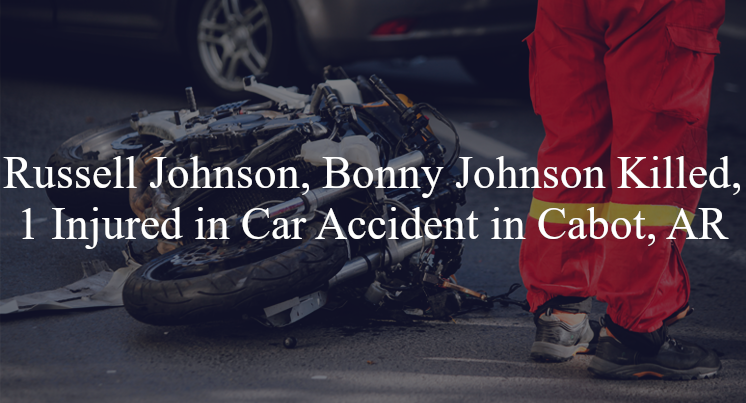Russell Johnson, Bonny Johnson Killed, 1 Injured in Car Accident in Cabot, AR
Cabot, AR — April 11, 2025, Two people were killed and one was injured in a car accident that occurred around 6:11 P.M. on SH 321.

An investigation is underway following a car accident that left two people dead and a child injured during the evening hours of April 11th. According to official reports, Russell Johnson and Bonny Johnson were traveling on a Harley Davidson motorcycle on Dogwood Lane in the westbound lanes, and were approaching the intersection with State Highway 321. As the motorcycle was passing through the intersection, a southbound Ford pickup was traveling on Dogwood Lane and in the path of the motorcycle, resulting in a collision.
When first responders arrived on the scene, they found that both Russell and Bonny Johnson had sustained fatal injuries and were pronounced deceased, while a minor occupant from the pickup received injuries of an unknown nature. At this time there has been no further information released from the accident, however this remains an ongoing investigation and more details may be released by authorities in the future.
Commentary
When a motorcycle enters an intersection and collides with a pickup truck, resulting in two fatalities and injuries to a child, it’s clear that something went deeply wrong. Crashes like this one—particularly those involving motorcycles—require more than a cursory review of the scene. To fully understand what happened, and why, we must begin with three critical questions: Did the authorities conduct a thorough investigation? Has anyone considered whether a vehicle defect contributed to the crash? And has all the relevant electronic data been collected?
First, the depth of the official investigation is essential. Intersections are among the most complex and dangerous places on the road, especially when visibility, timing, and right-of-way decisions come into play. In a crash where the motorcycle was reportedly traveling westbound and the pickup was approaching from the south on the same road, questions immediately arise about who entered the intersection first, who had the right of way, and whether any contributing factors like speed or line-of-sight issues were involved. These answers require more than just a basic police report. Investigators must carefully document the scene, analyze impact points, and reconstruct the events with precision. Without this level of analysis, we’re left with speculation instead of clarity.
Next, it’s important to consider whether a vehicle defect may have played a role—on either side. In the case of the motorcycle, sudden mechanical failures such as brake lock-up or throttle malfunction could have made it impossible to avoid the collision. On the pickup’s side, failures in steering, braking, or even lighting systems may have influenced the crash. These possibilities are often dismissed in the aftermath of fatal collisions, not because they’re unlikely, but because examining them requires technical expertise and time—resources not always built into standard crash responses. Unless someone asks these questions early and gathers the necessary evidence, that opportunity may be lost forever.
Finally, electronic data plays a critical role in understanding what happened. Modern pickups are typically equipped with electronic control modules (ECMs) that record vehicle behavior in the moments before a crash—such as speed, braking activity, and throttle position. This data can establish whether the driver attempted to stop, how fast they were traveling, and whether there was any mechanical response prior to the impact. While motorcycles like a Harley Davidson may not always include ECMs, other digital evidence—such as surveillance footage, traffic camera data, or cell phone activity—may help piece together the timeline. The key is collecting this evidence promptly, before it is lost or overwritten.
In the wake of a crash that claimed two lives and injured a child, the community deserves a full accounting of what happened. That begins by asking the right questions and pursuing the evidence wherever it leads. A detailed investigation, a willingness to consider mechanical causes, and the collection of electronic data are all essential if we’re going to provide answers—not just assumptions—for those left behind. Anything less leaves too much at risk.

*We appreciate your feedback and welcome anyone to comment on our blog entries, however all visitor blog comments must be approved by the site moderator prior to showing live on the site. By submitting a blog comment you acknowledge that your post may appear live on the site for any visitors to see, pending moderator approval. The operators of this site are not responsible for the accuracy or content of the comments made by site visitors. By submitting a comment, blog post, or email to this site you acknowledge that you may receive a response with regard to your questions or concerns. If you contact Grossman Law Offices using this online form, your message will not create an attorney-client relationship and will not necessarily be treated as privileged or confidential! You should not send sensitive or confidential information via the Internet. Since the Internet is not necessarily a secure environment, it is not possible to ensure that your message sent via the Internet might be kept secure and confidential. When you fill out a contact or comment form, send us an email directly, initiate a chat session or call us, you acknowledge we may use your contact information to communicate with you in the future for marketing purposes, but such marketing will always be done in an ethical way.